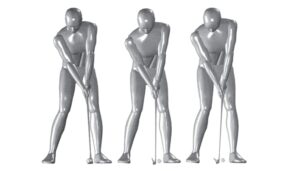Golf Instructions
The Art of Golf: Physical and Mental Mastery
Physical Aspects
-
The Grip: Your connection to the club begins here. Hold the club with a relaxed grip; imagine holding a bird—firm enough it won’t fly away, but gentle enough not to harm it. This balance prevents excess tension in your arms and shoulders, leading to a smoother swing.

-
Stance and Posture: Stand with your feet shoulder-width apart, knees slightly bent, and your body tilted at the hips, not the waist. Balance your weight evenly on the balls of your feet. Proper posture promotes a more efficient and powerful swing.

-
The Swing: Think of your swing as a pendulum, moving fluidly from backswing to impact to follow-through. Initiate the swing with your hips, not your arms. This generates power from your body’s core, reducing reliance on arm strength, which can lead to inconsistency.

-
Consistency in Practice: Regular practice is key. Work on all aspects of your game, from driving to putting. Use drills to reinforce muscle memory, and don’t shy away from practicing difficult shots to build confidence and versatility.
Mental Aspects
-
Focus and Visualization: Before each shot, take a moment to visualize the ball’s path. Picture the shot in your mind, from the swing to the ball landing on your intended spot. This mental imaging helps reinforce your body’s movements to execute the shot as planned.
-
Managing Emotions: Golf is a game of highs and lows. Learn to manage frustration and excitement. Maintain a steady emotional state; let go of bad shots immediately and stay calm after good ones. Consistency in your emotional response helps maintain focus throughout the round.
-
Strategic Thinking: Golf is not just about hitting the ball; it’s about smart play. Consider factors like wind, hazards, and course layout before deciding on your shot. Sometimes, a conservative strategy might yield better results than an aggressive one.
-
Routine: Develop a pre-shot routine that helps you set up consistently for every shot. This routine can help alleviate nerves and increase your focus. Whether it’s a couple of practice swings or a specific thought process, stick to your routine to maintain consistency under pressure.
-
Continuous Learning: Reflect on your games and learn from each experience. Identify areas for improvement and strengths to leverage. Keeping a mental or written log can help track your progress and set goals.
